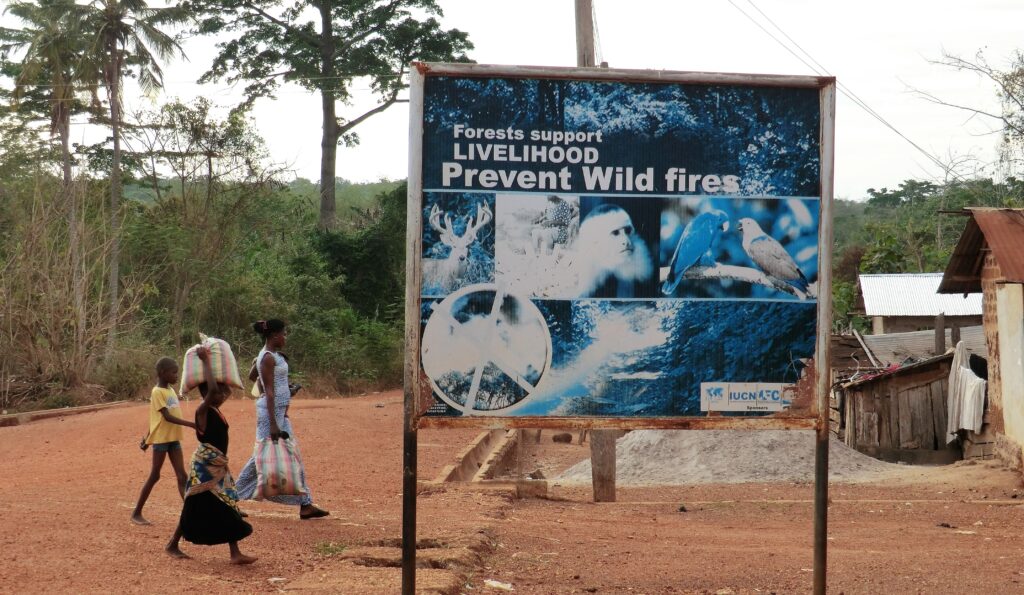Climate change and human activities like deforestation are causing more fires in central and west Africa’s wet, tropical forests, according to the first-ever comprehensive survey there. The fires have long been overlooked.
2 May 2024

Fires in Africa’s wet, tropical forests have doubled in recent decades, a new Geophysical Research Letters study found. Although Africa is known as “the fire continent,” larger savanna and woodland fires often dominate the region’s fire narrative and research. The photo shows a common sign about the prevention of forest fires in Ghana. Credit: M. Wimberly
AGU press contact:
Rebecca Dzombak, [email protected] (UTC-4 hours)
Contact information for the researchers:
Michael Wimberly, University of Oklahoma, [email protected] (UTC-5 hours)
The author should be contacted directly for interview requests.
WASHINGTON — A new study presents the first large-scale analysis of fire patterns in west and central Africa’s wet, tropical forests. The number of active fires there typically doubled over 18 years, particularly in the Congo Basin. The increases are primarily due to increasingly hot, dry conditions and humans’ impact on the forests, including deforestation. The increase in forest fires is likely to continue given current climate projections, according to the study.
With fires increasing in other historically wet forests, such as the U.S. Pacific Northwest and the Amazon, wet forest fires can no longer be ignored, the researchers say.
Scientists have known for decades that wet forests in western and central Africa have fires, but because the fires tend to be much smaller than their counterparts in dry woodlands and savannas, relatively little research has been done on Africa’s tropical forest fires. This has led to uncertainty over where and when they burn, what exacerbates them and how that might shift in response to climate change.
“Historically, scientists have not considered fire to be an important part of wet, tropical forests, but there’s been work in the Amazon in recent decades that has suggested otherwise,” said Michael Wimberly, an ecologist at the University of Oklahoma who led the study. “We need to start thinking about wet forests as being susceptible to fires and considering fire an important impact of climate change in tropical forests.”
The study was published in Geophysical Research Letters, which publishes high-impact, short-format reports with immediate implications spanning all Earth and space sciences.
Drier forests, frequent fires
Previous research on fires in wet, tropical African forests has typically focused on relatively small areas or used datasets that were not representative of the whole forest system. Wimberly’s new study is the first comprehensive assessment fire patterns in wet African forests, which are mostly ignited by humans.

Most fires burn on the edges of forests, where human activity—including deforestation—is most common. Hotter and drier weather from climate change has made fire-conducive conditions more common, according to the study. Credit: Axel Fassio/CIFOR
The researchers used satellite imagery to track active fires from 2003 to 2021 in western and central Africa, including the Congo Basin. The researchers found an unambiguous increase in fire frequency over time. The greatest increases were in the Northwest Congolian Lowland Forests, where there were 400 more active fires per 10,000 square kilometers (3,861 square miles) annually, in 2021 as compared to 2003. Across most of the Congo Basin, active fire densities typically doubled over the study period.
Areas with rapid forest loss, or deforestation, also saw more fire activity. Deforestation is associated with high levels of human activity and fragments the remaining forests, increasing the length of exposed edges where most fires burn. A forest’s edge has a drier microclimate and more invasive species than interior forests, making it more susceptible to fire.
The researchers also compared fire occurrences to weather patterns and found clear associations between fires, high temperatures and vapor pressure deficit, which is an indicator of plant water stress. They found a particularly strong relationship during the 2015-2016 “super El Niño,” which brought anomalous heat and drought conditions to tropical Africa.
“I was surprised at how strong and clear the climate signal was,” Wimberly said.
The findings provide critical insights into how climate change could influence African forest fire activity, particularly during El Niño years, and highlight the need to control fires at forests’ edges to prevent harmful feedback loops: A fire-affected forest is more likely to have less canopy cover and more fragmentation, increasing its fire risk.
“Tropical forest fires have been long overlooked, but they’re only going to become more important in the future,” Wimberly said. “We can’t ignore them any longer.”
#
Notes for journalists:
This study is published in Geophysical Research Letters, an open-access AGU journal. Neither this press release nor the study is under embargo. View and download a pdf of the study here.
Paper title:
“Increasing fire activity in African tropical forests is associated with deforestation and climate change”
Authors:
- Michael C. Wimberly (corresponding author), D. Wanyama, Department of Geography and Environmental Sustainability, University of Oklahoma, OK, USA, now Department of Geography, University of Connecticut, CT, USA
- R. Doughty, College of Atmospheric and Geographic Sciences, University of Oklahoma, OK, USA
- H. Peiro, College of Atmospheric and Geographic Sciences, University of Oklahoma, OK, USA; and Netherlands Institute for Space Research, Leiden, the Netherlands
- S. Crowell, College of Atmospheric and Geographic Sciences, University of Oklahoma, OK, USA; and LumenUs Scientific, OK, USA
AGU (www.agu.org) is a global community supporting more than half a million advocates and professionals in Earth and space sciences. Through broad and inclusive partnerships, AGU aims to advance discovery and solution science that accelerate knowledge and create solutions that are ethical, unbiased and respectful of communities and their values. Our programs include serving as a scholarly publisher, convening virtual and in-person events and providing career support. We live our values in everything we do, such as our net zero energy renovated building in Washington, D.C. and our Ethics and Equity Center, which fosters a diverse and inclusive geoscience community to ensure responsible conduct.